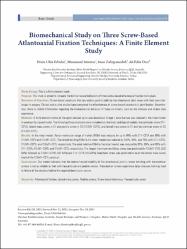Biomechanical study on three screw-based atlantoaxial fixation techniques: A finite element study

Göster/
Erişim
info:eu-repo/semantics/openAccessAttribution-NonCommercial 4.0 Internationalhttps://creativecommons.org/licenses/by-nc/4.0/Tarih
2022Üst veri
Tüm öğe kaydını gösterKünye
Erbulut, D. U., Mumtaz, M., Zafarparandeh, I. ve Özer, A. F. (2022). Biomechanical study on three screw-based atlantoaxial fixation techniques: A finite element study. Asian Spine Journal, 16(6), 831-838. https://dx.doi.org/10.31616/ASJ.2021.0270Özet
Study Design: This is a finite element study. Purpose: This study is aimed to compare the biomechanical behaviors of three screw-based atlantoaxial fixation techniques. Overview of Literature: Screw-based constructs that are widely used to stabilize the atlantoaxial joint come with their own challenges in surgery. Clinical and in vitro studies have compared the effectiveness of screw-based constructs in joint fixation. Nevertheless, there is limited information regarding the biomechanical behavior of these constructs, such as the stresses and strains they experience. Methods: A finite element model of the upper cervical spine was developed. A type II dens fracture was induced in the intact model to produce the injured model. The following three constructs were simulated on the intact and injured models: transarticular screw (C1– C2TA), lateral mass screw in C1 and pedicle screw in C2 (C1LM1–C2PD), and lateral mass screw in C1 and translaminar screw in C2 (C1LM1–C2TL). Results: In the intact model, flexion–extension range of motion (ROM) was reduced by up to 99% with C11–C2TA and 98% with C1LM1–C2PD and C1LM1–C2TL. The lateral bending ROM in the intact model was reduced by 100%, 95%, and 75% with C11–C2TA, C1LM1–C2PD, and C1LM1–C2TL, respectively. The axial rotation ROM in the intact model was reduced by 99%, 98%, and 99% with C11–C2TA, C1LM1–C2PD, and C1LM1–C2TL, respectively. The largest maximum von Mises stress was predicted for C1LM1–C2TL (332 MPa) followed by C1LM1–C2PD (307 MPa) and C11–C2TA (133 MPa). Maximum stress was predicted to be at the lateral mass screw head of the C1LM1–C2TL construct. Conclusions: Our model indicates that the biomechanical stability of the atlantoaxial joint in lateral bending with translaminar screws is not as reliable as that with transarticular and pedicle screws. Translaminar screws experience large stresses that may lead to failure of the construct before the required bony fusion occurs.
Scopus Q Kategorisi
Q1Kaynak
Asian Spine JournalCilt
16Sayı
6Koleksiyonlar
İlgili Öğeler
Başlık, yazar, küratör ve konuya göre gösterilen ilgili öğeler.
-
Comparison of screw fixation with elastic fixation methods in the treatment of syndesmosis injuries in ankle fractures
Seyhan, Mustafa; Dönmez, Ferdi; Mahiroğulları, Mahir; Çakmak, Selami; Mutlu, Serhat; Güler, Olcay (Elsevier, 2015)17 patients with ankle syndesmosic injury were treated with a 4.5 mm single cortical screw fixation (passage of screw 4 cortices) and 15 patients were treated with single-level elastic fixation material. All patients were ... -
Treatment of adolescent idiopathic scoliosis with global (ROD) derotation maneuver using pedicle screws
Kaya, Özcan; Akgül, Turgut; Özkunt, Okan; Dikici, Fatih; Yazıcıoğlu, Önder; Domaniç, Ünsal (Turkish Spinal Surgery Society, 2018)Introduction: Adolescent idiopathic scoliosis is a three dimensional deformity. For the treatment of deformity, nature of deformity should be well understood and treatment strategy has to be directed to the coronal, sagittal ... -
Mini-plate fixation via sinus tarsi approach is superior to cannulated screw in intra-articular calcaneal fractures: A prospective randomized study
Kır, Mustafa Çağlar; Ayanoğlu, Semih; Çabuk, Haluk; Dedeoǧlu, Süleyman Semih; İmren, Yunus; Karslıoğlu, Bülent; Yüce, Ali; Gürbüz, Hakan (Sage Publications Inc, 2018)Objective: Intra-articular displaced calcaneal fractures are common fractures and are often treated with surgical interventions. Sinus tarsi approach provides secure access to lateral wall and joint facets. The aim of the ...


















